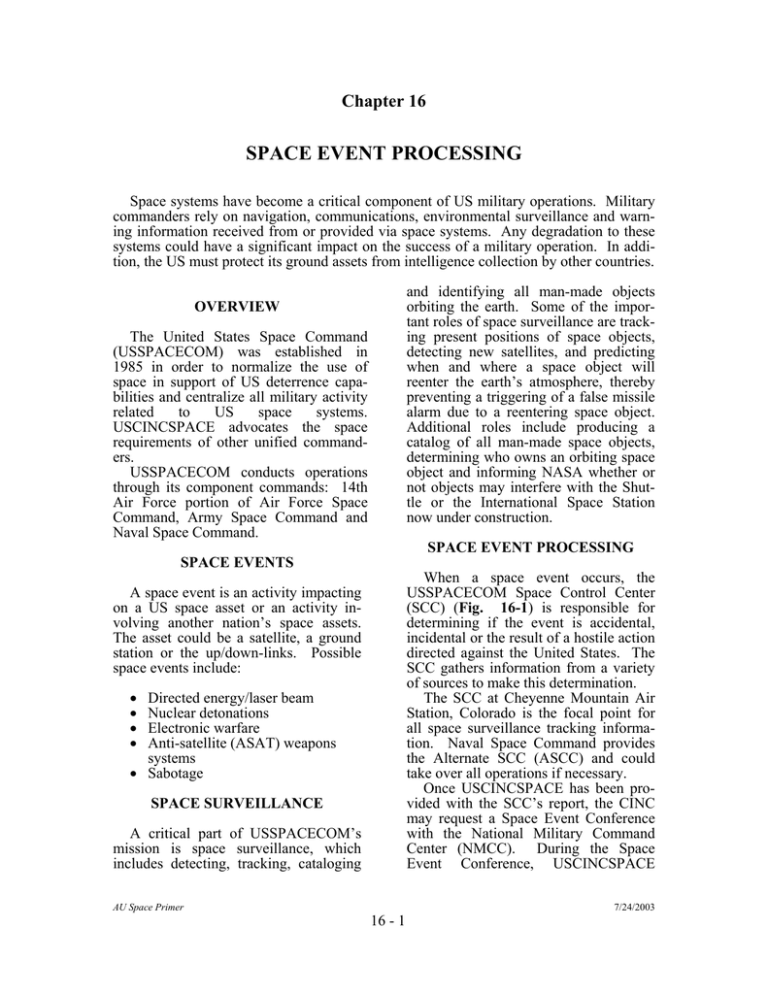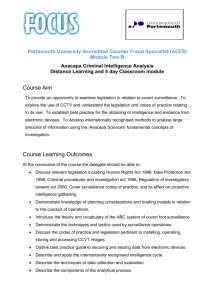SPACE EVENT PROCESSING Chapter 16
advertisement

Chapter 16 SPACE EVENT PROCESSING Space systems have become a critical component of US military operations. Military commanders rely on navigation, communications, environmental surveillance and warning information received from or provided via space systems. Any degradation to these systems could have a significant impact on the success of a military operation. In addition, the US must protect its ground assets from intelligence collection by other countries. and identifying all man-made objects orbiting the earth. Some of the important roles of space surveillance are tracking present positions of space objects, detecting new satellites, and predicting when and where a space object will reenter the earth’s atmosphere, thereby preventing a triggering of a false missile alarm due to a reentering space object. Additional roles include producing a catalog of all man-made space objects, determining who owns an orbiting space object and informing NASA whether or not objects may interfere with the Shuttle or the International Space Station now under construction. OVERVIEW The United States Space Command (USSPACECOM) was established in 1985 in order to normalize the use of space in support of US deterrence capabilities and centralize all military activity related to US space systems. USCINCSPACE advocates the space requirements of other unified commanders. USSPACECOM conducts operations through its component commands: 14th Air Force portion of Air Force Space Command, Army Space Command and Naval Space Command. SPACE EVENT PROCESSING SPACE EVENTS When a space event occurs, the USSPACECOM Space Control Center (SCC) (Fig. 16-1) is responsible for determining if the event is accidental, incidental or the result of a hostile action directed against the United States. The SCC gathers information from a variety of sources to make this determination. The SCC at Cheyenne Mountain Air Station, Colorado is the focal point for all space surveillance tracking information. Naval Space Command provides the Alternate SCC (ASCC) and could take over all operations if necessary. Once USCINCSPACE has been provided with the SCC’s report, the CINC may request a Space Event Conference with the National Military Command Center (NMCC). During the Space Event Conference, USCINCSPACE A space event is an activity impacting on a US space asset or an activity involving another nation’s space assets. The asset could be a satellite, a ground station or the up/down-links. Possible space events include: • • • • Directed energy/laser beam Nuclear detonations Electronic warfare Anti-satellite (ASAT) weapons systems • Sabotage SPACE SURVEILLANCE A critical part of USSPACECOM’s mission is space surveillance, which includes detecting, tracking, cataloging AU Space Primer 16 - 1 7/24/2003 describes the activity and will provide one of the following assessments: tool that informs customers of expected foreign intelligence satellite overflights. SATRAN reporting is site-specific and provides sufficient warning to allow recipients time to respond to a potential threat by employing cover, concealment or cessation of activity until the threat is passed. Under JCS guidance, the Defense Intelligence Agency (DIA) is the manager for SATRAN. Operational execution of the program has been delegated to the USSPACECOM Combined Intelligence Center (CIC) at Peterson AFB, Colorado. The Naval Space Operations Center (NAVSPOC), a component of Naval Space Command, is delegated the responsibility of providing satellite reconnaissance OPSEC support to US Navy and Marine Corps assets only. Likewise, the US Army White Sands Missile Range (WSMR) produces satellite overflight times for users of the White Sands Ranges only. • NO—An attack against a space system has not occurred nor is one in progress. • CONCERN—Events are occurring that has raised the level of concern. Further assessment is necessary in order to determine the nature of the activity involved. Pending completion of the ongoing assessment, precautionary measures to enhance responsiveness or survivability are suggested. • YES—A verified attack against a space system has occurred. This means that all-source data confirms the hostile event has occurred or is occurring. CONCLUSION The nature of space operations is such that its theater of operations is not normally host to the personnel affected. USCINCSPACE has no combat forces assigned. Also, all of USSPACECOM’s ground facilities are located in another Commander-in-Chief’s area of responsibility. As a result, when a verified attack occurs or is in progress, USCINCSPACE relies on the other unified commanders to protect US assets and, when necessary, respond to space events with force. USSPACECOM’s Space Control Center and the Combined Intelligence Center provide other unified commanders with the information necessary to avoid threats to space or ground systems. Fig. 16-1. Space Control Center Operator SATELLITE RECONNAISSANCE ADVANCE NOTICE (SATRAN) PROGRAM USSPACECOM is tasked by Annex A of the Joint Strategic Capabilities Plan (JSCP) to provide timely notification of potential space-based reconnaissance of US forces worldwide by a foreign nation. This program is known as SATRAN and is a proven, reliable Operations Security (OPSEC) support AU Space Primer 16 - 2 7/24/2003 REFERENCE USSPACECOM REG 55-10. AU Space Primer 16 - 3 7/24/2003



